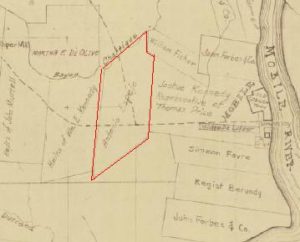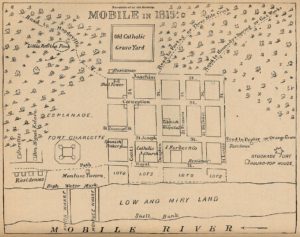Catalina Plock [Bloque] Espejo Mottus
(17 April 1781- 9 Sep 1862)1 2
Widow and Relic of (married 1789)3 Antonio Espejo (unk.- 1805)4
. . . Plock and his wife died of exposure, due to being captured by Indians and dragged to Pensacola. Their little daughter Catalina, then nine months old, was dashed against a tree and left by the savages for dead, but was found, and was brought up by Fontanillas on the west side of Mobile Bay. She lived to become Madame Antonio Espejo.5
 Illustration 1: Eight-year-old Bride
Illustration 1: Eight-year-old Bride
Catalina Plock orphaned by cruel fate, and marauding hostiles was rescued by Francisco Fontanillas. [Francis Fontinille] raised the orphan as his own; and prepared her for life along the Gulf Shores, as an eligible bride for the wealthiest possible match. At eight years, Catalina assumed the duties of a naive but wealthy bride, the infant wife to Antonio Espejo. Her household was complex and unmanageable for her youth, but there were plenty of servants to provide relief. Evidently, Antonio was a patient husband, for their eldest child did not arrive before Catalina’s 18th year. Their union produced at least two daughters, Catherine and Gertrude, and a son. Antonio was born 1798, and confirmed 26 April 1798. His Godfather was Isidro Guintero.6 Antonio Espejo Junior died without issue.
Supervisor of the King’s Bakery, and royal carpenter Antonio Espejo, from Malaga, Andalusia, Spain, perished from yellow fever, during the plague of 1805. He was interred in the Catholic Cemetery at Mobile. Catalina nee Plock, daughter of Andre [Bloque] survived Antonio, and remarried.
 Illustration 2: Espejo’s Tract at Mobile
Illustration 2: Espejo’s Tract at Mobile
Antonio Espejo was obviously named for the 16th-century conquistador, but has a less glorious history.
Anthony, Catherine and Gertrude Espejo were enumerated under their father’s name for land conveyed by Spanish permit March 22nd, 1803, two years before their father’s death.7 Additionally, their mother, newly-married Catalina [Catherine] Mottus was enumerated with her children in the registration of lands east of the Pearl River, for April 11, 1804, in 1816.8 And again, Madame Espejo protects her children’s rights to the Espejo Tract, before the Creek Indian War.9 She married Silvain Mottus, Private and member of the 14th McVoy’s Regiment in the Mississippi Militia, before he went off to fight in the War of 1812,10 for the duration. Silvain Mottus [Silvaint Motters] owned a large piece of property, about 4,800 acres at Mobile, but he may yet have married Catalina for her money.11 May they rest in peace. Amen.
 Illustration 3: Old Catholic Grave Yard at Mobile
Illustration 3: Old Catholic Grave Yard at Mobile
©2018- 2022 Carolyn E. Kourdache
1Andrews, Johnnie, William David Higgins, Creole Mobile: A Compendium of the Colonial Families of the Central Gulf Coast 1702-1813, page
2“Find A Grave Index,” database, FamilySearch (https://familysearch.org/ark:/61903/1:1:QVV5-JG7W : 13 December 2015), Catalina Mottus, 1862; Burial, Mobile, Mobile, Alabama, United States of America, Church Street Cemetery; citing record ID 25616319, Find a Grave, http://www.findagrave.com.
3Ibid.
4Ibid.
5Hamilton, Peter J.. Colonial Mobile : an historical study, largely from original sources, of the Alabama-Tombigbee Basin and the old South West from the discovery of the Spiritu Santo in 1519 until the demolition of Fort Charlotte in 1821. Boston: Houghton Mifflin, 1910, Appendix, “In the Creole Country,” page 516
6Johnnie Andrews.
7A Century of Lawmaking for a New Nation: U.S. Congressional Documents and Debates, 1774 – 1875
American State Papers, House of Representatives, 14th Congress, 1st Session
Public Lands: Volume 3 Page 9
8Ibid.
9Ibid. Page 10.
10United States War of 1812 Index to Service Records, 1812-1815, database with images, FamilySearch (https://familysearch.org/ark:/61903/1:1:Q29K-V83V : 11 March 2016), Silvain Mottus, 1812-1815; citing NARA microfilm publication M602 (Washington, D.C.: National Archives and Records Administration, n.d.); roll 149; FHL microfilm 882,667.
11American State Papers, House of Representatives, 14th Congress, 1st Session
Public Lands: Volume 3 Page 17.